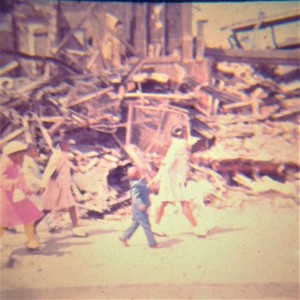Keeping the Faith

Easter Sunday 1968. It was April 14. The Rev. Dr. Martin Luther King, Jr., had been assassinated in Memphis on April 4. In those intervening ten days, rioting, looting and arson broke out in 196 cities in 36 states and the District of Columbia. The nation’s capital saw four days and nights of rioting or, as some preferred to call it, civil disorders, from April 4 through April 8. Federal troops patrolled the streets. By the end, in DC, there were 13 dead, 1,000 injured and 6,100 arrested.
My first newspaper job took me to Washington in 1964 and 1965. From there, I went to work for the Philadelphia Evening & Sunday Bulletin. That city’s three days of racial rioting was in 1964. This time there was none, and DC beckoned me back on the weekend that followed the city’s uprising. I was not on assignment, but my newspaper instincts were to witness the aftermath.
The “riot corridors” were three predominantly black business districts, 7th Street NW, 14th Street NW, and H Street NE. After I moved back to Washington in 1970 to work for The Washington Post one of my early assignments was to cover the D.C. Redevelopment Agency, which oversaw the rebuilding of these three federally designated urban renewal areas.
The story then was all about disinvestment. The riots had devastated these already low-income black neighborhoods: White merchants had fled, and there were blocks of vacant and boarded up rowhouses. Except for a couple of subsidized housing projects sponsored by church groups, and despite millions of federal dollars invested, there was little of the hoped for progress.
There was disbelief and more than a little skepticism when the District government proposed selling one of its distressed apartments to private investors to rehab and sell or rent on the open market. There were no takers. At the time, no one could foresee the gentrification that would later transform the neighborhoods — racially and economically — in the future.
On Easter Sunday 1968 there were just ruins and rubble. Always the reporter, I could not resist driving up 7th and 14th Streets NW to capture the scene, for what I wasn’t sure, maybe for now.
From my car, I snapped 20 slides of the devastation. Twisted shells of commercial buildings, torched metal frames of burned out structures, a storefront with a handwritten sign that signified the business belonged to a “Soul Brother,” its owner hoping for some compassion, a playground named for John F. Kennedy that was in no condition to be a place for children to play.
But of the 20 pictures — all but four on 7th Street — one in particular rivets me still. In it, five black children are dressed up in their best Easter Sunday clothes. They are walking past the rubble of what was once a building. Four girls, one boy. The girls are holding hands. They are looking ahead. The girl in the lead is holding the hand of presumably her younger brother, who is wearing a blue suit. Only he is gazing to the left, to the ruins that must have been bewildering.
The image is blurry. But one thing is crystal clear. Amid all the destruction, and all the reasons to despair, these five children, with a quiet dignity on Easter Sunday 1968, were keeping the faith.
Now, 56 years later, comes another Easter, a holiday symbolic of resurrection and rebirth, and, soon to come, another Passover, the holiday that marks the Jewish exodus from Egypt and from slavery to freedom. These are, again, dark times, but I cannot help but be inspired by this fuzzy image. It gives me hope that perhaps, as the song goes, we shall overcome some day.
***
The 20 images referenced above — and related items — are included in the Eugene L. Meyer Papers at the Smithsonian’s Anacostia Community Museum. The summary description:
“The papers of journalist Eugene L. Meyer measure 6.22 linear feet and date from circa 1969 to 2008. The papers include correspondence; clippings; research files; newsletters; handwritten notes; drafts of some of Meyer’s articles; as well as editions of a Washington, DC neighborhood newsletter, which Meyer edited from 1989 to 1995. Also included in the collection are photographic slides of Washington, DC on Easter Sunday in April 1968, just days following the assassination of Reverend Dr. Martin Luther King, Jr. and the subsequent civil disturbances.”
Gene, I always enjoy your blog and appreciate your linking history to present times. Also admire your having made the donation and referring to your papers at the Museum. Keep it going, Eileen McG
Excellent update, Gene. It sure makes me think.
Very impactful and inspiring photo and post. Thank you for sharing!